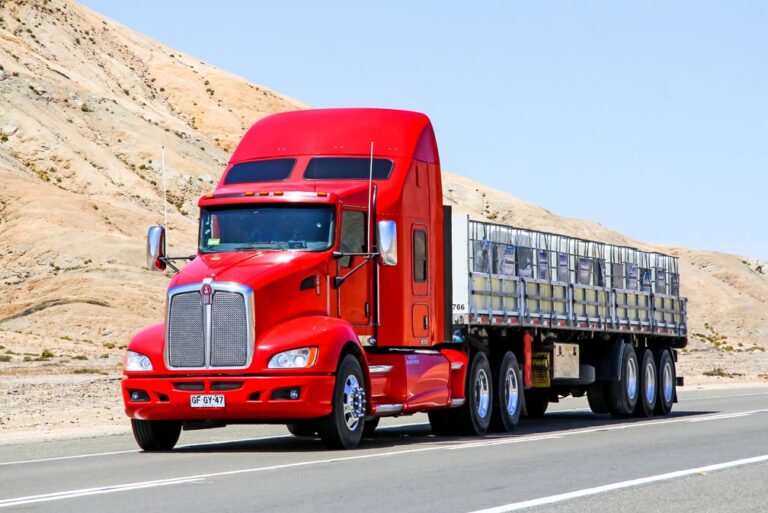COLUMBUS, Ind., and BLOOMINGTON, Ind. — The war in Ukraine, inflation and the impacts of recent COVID-19 lockdowns in China made for a rocky ride in the trucking industry in April, as reflected by reports issued by analysts at both ACT Research and FTR.
According to ACT’s latest release of the North American Commercial Vehicle Outlook, while ACT analysts are pleased with the footing of the U.S. economy — with consumers sitting on considerable savings, debt-service historically low, and the job market flush with opportunity — the risks are still there.
“Given the corrosive effects of inflation and the Fed’s response, uncertainty as to the depth and duration of events in Ukraine, and the impact of Chinese COVID lockdowns on global supply chains, the economy is walking a fine line in 2022,” said Kenny Vieth, president and senior analyst at ACT.
“Trucking industry profits tend to lag the freight cycle, so are likely to peak around Q3 ’22,” he continued. “As profits lag relative to the cycle, so too does production for heavy-duty trucks and trailers.”
Despite the lowered build forecast in the most recent issue of ACT’s North American CV (commercial vehicle) Outlook, “It is important to remember that we continue to expect higher build, just not as high as previously thought. Carrier profitability is robust, and should there be a recession, we anticipate that it will be shallow and short-lived, and pent-up demand for medium- and heavy-duty vehicles still remains,” he said.
“The headline takeaway is that we have lowered our 2023 Class 8 build forecast. Our tempered view reflects: 1) a longer tail to supply-chain headwinds than we had previously envisioned, particularly for semiconductors, and 2) lower in-house GDP and Freight Composite estimates,” he continued.
NEW COMMERCIAL VEHICLE ORDERS STAGNANT
ACT data showed preliminary Class 8 net orders of 15,800 units, while orders for Classes 5-7 units slid to 19,500. FTR analysts showed similar figures, with a 28% drop month over month and a significant 56% drop year over year. According to FTR, this is the largest month-over-month change so far this year.
“April’s order total does not accurately reflect the current demand for new trucks. It does however reflect a market that is trying to minimize its exposure to the headwinds it could potentially face in 2023,” said Charles Roth FTR’s commercial vehicle analyst.
“As production continues to be significantly impacted by supply chain disruptions, component shortages, labor shortages, and increased material costs, the hesitancy to open 2023 order boards stems from not being able to guarantee pricing given the current environment. Once supply chain issues improve, OEMs will be able to substantially increase orders. But until then, conditions remain stagnant.”
Eric Crawford, vice president and senior analyst for ACT, pointed to a combination of constrained production capabilities and the existing backlog ahead of the industry’s 12-month build plan as a primary factor in the lack of new orders.
“Recent commentary from the semiconductor industry is discouraging, with ASML, a key supplier of semiconductor production equipment, pointing to a ‘significant shortage of semiconductor manufacturing capacity this year and next,’ suggesting headwinds to OEM production capacity and by extension, lower-for-longer orders potentially into 2023,” Crawford said.
With backlogs largely full for the year, OEM’s have yet to open their order boards for 2023. Given all the unknowns faced in today’s business environment OEMs are carefully monitoring their backlogs and continuing to evaluate monthly how far into the future they are willing to push them, according to both agencies.
USED TRUCK SALES LAG
Preliminary used Class 8 volumes (same dealer sales) fell 40% month over month in April and were 33% lower compared to April of 2021, according to ACT’s preliminary release of its State of the Industry: U.S. Classes 3-8 Used Trucks.
“In the inventory-challenged world used truck buyers and sellers find themselves these days, it should come as no surprise that sales volumes fell in April,” said Steve Tam, vice president of ACT.
“March’s gains (+53%) came on the heels of the strong December new truck sales market (+49%),” he noted. “Looking back at January new truck sales (-39%), is it any wonder that April preliminary used truck sales were off a corresponding percentage (-40%)?”
Other data released in ACT’s preliminary report included month-over-month comparisons for April 2022, which showed that the average retail price of a used commercial vehicle rose 10%, and average miles and age were both lower, down 5% and 6%, respectively, from March. Compared to April of 2021, the average retail price was 77% higher, with average miles and age greater by 3% and 7%, respectively.
“The preliminary average retail selling price for Class 8 trucks eked out another record in April, and prices were unaffected by miles and age, which were up for all time period comparisons, yet another signal of the stale and lingering imbalance between supply and demand,” Tam said. “Looking ahead, if April is not the peak for prices, then the zenith cannot be far off. Slowing freight and freight rates confirm the assertion.”
ACT’s Classes 3-8 Used Truck Report provides data on the average selling price, miles and age based on a sample of industry data. In addition, the report provides the average selling price for top-selling Class 8 models for each of the major truck OEMs — Freightliner (Daimler); Kenworth and Peterbilt (Paccar); International (Navistar); and Volvo and Mack (Volvo).
TRAILER ORDERS DOWN
ACT’s preliminary reports show net trailer orders in April were 16,100 units, down almost 60% from the previous month and up slightly from the same month last year. Final April results will be available later this month. This preliminary market estimate should be within +/- 3% of the final order tally.
According to FTR calculations, preliminary trailer orders fell to 16,800 units in April, 53% below March, with trailer orders for the past 12 months standing at 252,000 units.
“While seasonal patterns call for a sequential decline in net orders in April, preliminary reports indicate that volumes fell more than might have been expected. Just as dry vans provided solid support in March, they were responsible for the dramatically lower April bookings,” said Frank Maly, director of commercial vehicle transportation analysis and research at ACT research.
Don Ake, vice president of commercial vehicles at FTR, noted that lockdowns in China, along with a state of unrest in Eastern Europe, are impacting market slowdowns.
“There is no reason for trailer OEMs to overbook, with increasing uncertainties regarding the supply chain. The situation in Shanghai is going to delay some components that are needed to make trailers. In addition, the war in Europe is creating shortages of aluminum with an associated spike in pricing,” Ake said. “These and other doubts have delayed OEMs from issuing quotes for 2023 requirements. So, the low order volumes reflect OEMs filling in the months of the 2022 production schedule they feel more confident about.
“The pent-up demand for trailers is estimated at over 100,000 units,” Ake continued. “But now, the supply chain difficulties are expected to extend into 2023. OEMs will then have to build at high rates for an extended time to catch up to demand. The short-term prospects are subdued, but the long-term outlook remains bright.”
Because of a variety of factors, OEMs are closely monitoring acceptance of orders, according to Maly.
“While some may think recent economic challenges could be a contributing factor to the sequential decline, it’s more likely that a reluctance to push the orderboard horizon into next year is responsible, as OEMs continue to closely control order acceptance,” Maly said.
“Final reporting will likely show that these lower order levels will still result in an average backlog-to-build ratio of just over eight months for the total industry. That will stretch through the end of the year at current production levels,” he continued. “Our discussions indicate active negotiations between OEMs and fleets continue, as fleets prepare to make commitments for 2023 production, when that opportunity becomes available.”
FREIGHT FORECAST
Tim Denoyer, vice president and senior analyst for ACT offered the following thoughts on the current freight market.
“As recently as the start of the year, pricing power in the truckload market was firmly with fleets. But once a pendulum gets going, it’s very hard to stop, he said. “Not coincidentally, the supply-demand balance in our For-Hire Survey turned loose this month, for the first time since June 2020, as the rebalancing, drawn-out by the pandemic, hit critical mass.”
Analysts at ACT have received numerous questions about the role of the freight sector as a leading indicator of the economy, he noted.
“While we agree it is a leading indicator, it’s mainly for the goods economy, rather than the larger service sector,” he said. “We also agree that Russia’s war has a tough-to-quantify but clearly adverse macro impact, and softer freight volumes are consistent with a slower economy.”
In addition, Denoyer said, he believes the driver shortage is over.
“The record drop-in spot rates in the past few months has been magnified by Russia and Omicron, but still clearly says the market has shifted to a driver surplus,” he said. “We’re not adding nearly as much equipment capacity as we typically would, which suggests a possibly shorter-than-normal downcycle.”
The Trucker News Staff produces engaging content for not only TheTrucker.com, but also The Trucker Newspaper, which has been serving the trucking industry for more than 30 years. With a focus on drivers, the Trucker News Staff aims to provide relevant, objective content pertaining to the trucking segment of the transportation industry. The Trucker News Staff is based in Little Rock, Arkansas.















